Comprehensive Presentation: Mycobacterium tuberculosis - Lab 5 Report
VerifiedAdded on 2022/09/22
|13
|1210
|44
Presentation
AI Summary
This presentation comprehensively analyzes Mycobacterium tuberculosis, covering its definition as an acid-fast, rod-shaped bacterium. It details the taxonomic classification, signs, and symptoms such as persistent cough, fever, and weight loss. The presentation explores the causes of TB, including droplet transmission and drug resistance. Diagnostic methods, including TB skin tests, blood tests, and imaging, are discussed. Treatment options, including drug combinations like isoniazid and rifampin, and the use of additional drugs for drug-resistant cases are also highlighted. The presentation concludes with an overview of TB epidemiology, referencing WHO data on global prevalence and mortality, including the countries most affected. The presentation is well-researched, referencing key studies and providing a thorough understanding of the microorganism.

MYCOBACTERIUM
TUBERCULOSIS
( N A M E O F T H E S T U D E N T )
TUBERCULOSIS
( N A M E O F T H E S T U D E N T )
Paraphrase This Document
Need a fresh take? Get an instant paraphrase of this document with our AI Paraphraser
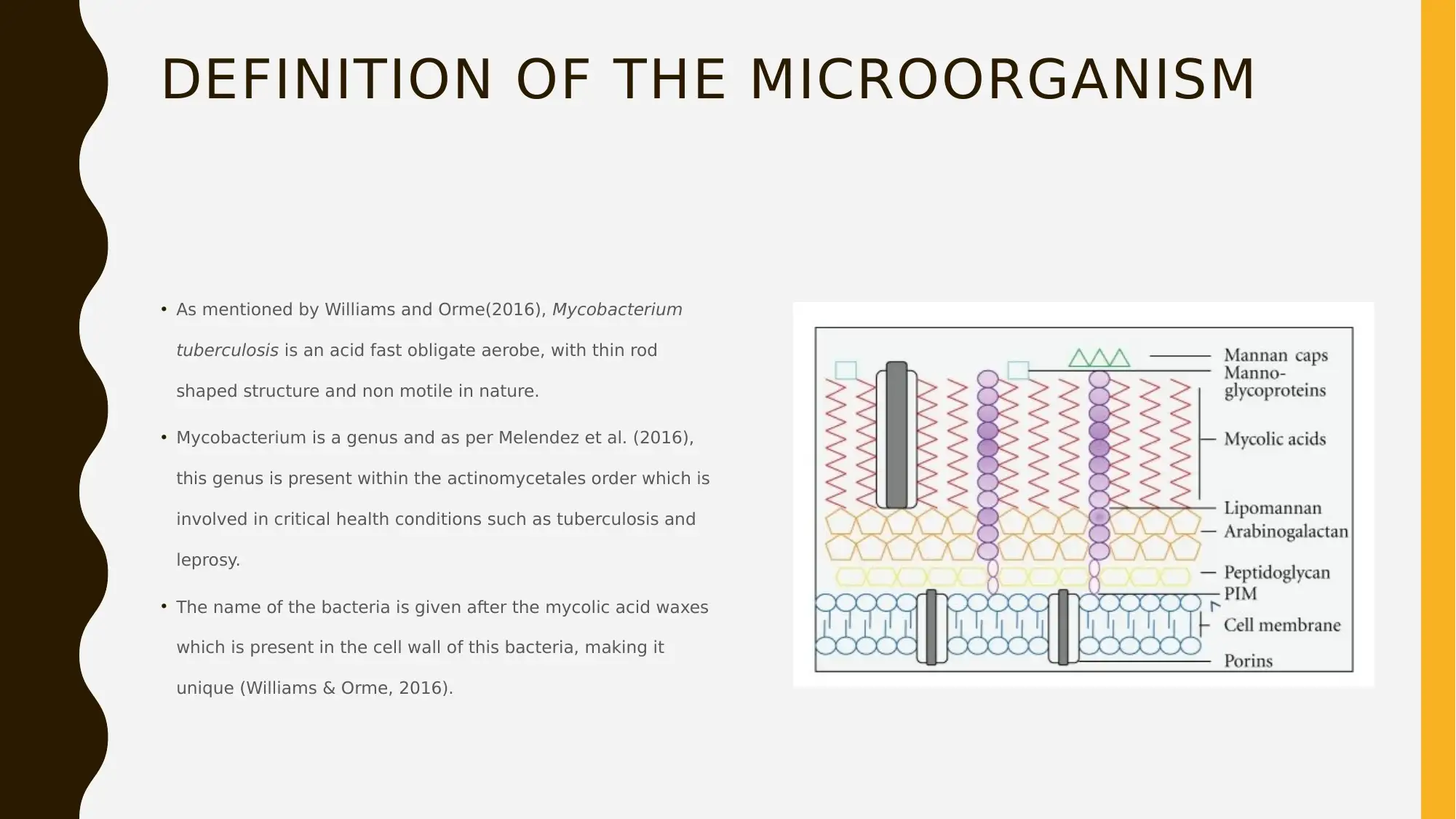
DEFINITION OF THE MICROORGANISM
• As mentioned by Williams and Orme(2016), Mycobacterium
tuberculosis is an acid fast obligate aerobe, with thin rod
shaped structure and non motile in nature.
• Mycobacterium is a genus and as per Melendez et al. (2016),
this genus is present within the actinomycetales order which is
involved in critical health conditions such as tuberculosis and
leprosy.
• The name of the bacteria is given after the mycolic acid waxes
which is present in the cell wall of this bacteria, making it
unique (Williams & Orme, 2016).
• As mentioned by Williams and Orme(2016), Mycobacterium
tuberculosis is an acid fast obligate aerobe, with thin rod
shaped structure and non motile in nature.
• Mycobacterium is a genus and as per Melendez et al. (2016),
this genus is present within the actinomycetales order which is
involved in critical health conditions such as tuberculosis and
leprosy.
• The name of the bacteria is given after the mycolic acid waxes
which is present in the cell wall of this bacteria, making it
unique (Williams & Orme, 2016).

TAXONOMIC CLASSIFICATION
• Kingdom: Bacteria
• Phylum: Actinobacetria
• Order: Actinomycetales
• Suborder: Corynebacterineae
• Family: Mycobacteriaceae
• Genus: Mycobacterium
• Species: Mycobacterium tuberculosis (Azé et al., 2015)
• Kingdom: Bacteria
• Phylum: Actinobacetria
• Order: Actinomycetales
• Suborder: Corynebacterineae
• Family: Mycobacteriaceae
• Genus: Mycobacterium
• Species: Mycobacterium tuberculosis (Azé et al., 2015)
⊘ This is a preview!⊘
Do you want full access?
Subscribe today to unlock all pages.

Trusted by 1+ million students worldwide
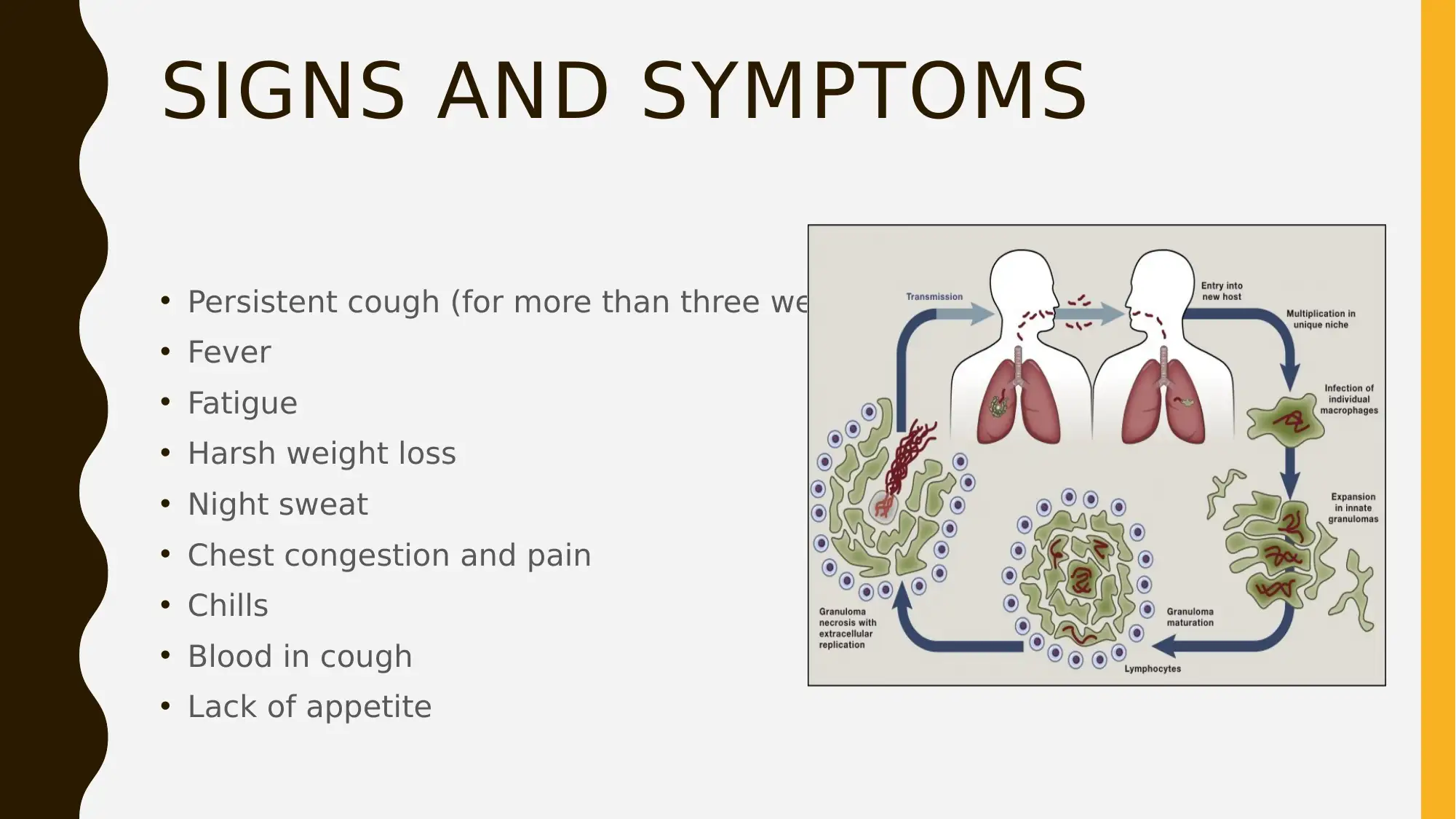
SIGNS AND SYMPTOMS
• Persistent cough (for more than three weeks)
• Fever
• Fatigue
• Harsh weight loss
• Night sweat
• Chest congestion and pain
• Chills
• Blood in cough
• Lack of appetite
• Persistent cough (for more than three weeks)
• Fever
• Fatigue
• Harsh weight loss
• Night sweat
• Chest congestion and pain
• Chills
• Blood in cough
• Lack of appetite
Paraphrase This Document
Need a fresh take? Get an instant paraphrase of this document with our AI Paraphraser

CAUSES (C0NT…)
• Drug resistance could be another reason for the spread of tuberculosis
increased. It should be mentioned that due to modification in the drug
development, the bacteria has become resistant to the disease conditions.,
due to which this disease occurs.
• The patients affected with HIV shows higher number of tuberculosis
conditions as due go the presence of HIV their immune system got
suppressed and due to this the patient develops tuberculosis related risk
• Drug resistance could be another reason for the spread of tuberculosis
increased. It should be mentioned that due to modification in the drug
development, the bacteria has become resistant to the disease conditions.,
due to which this disease occurs.
• The patients affected with HIV shows higher number of tuberculosis
conditions as due go the presence of HIV their immune system got
suppressed and due to this the patient develops tuberculosis related risk
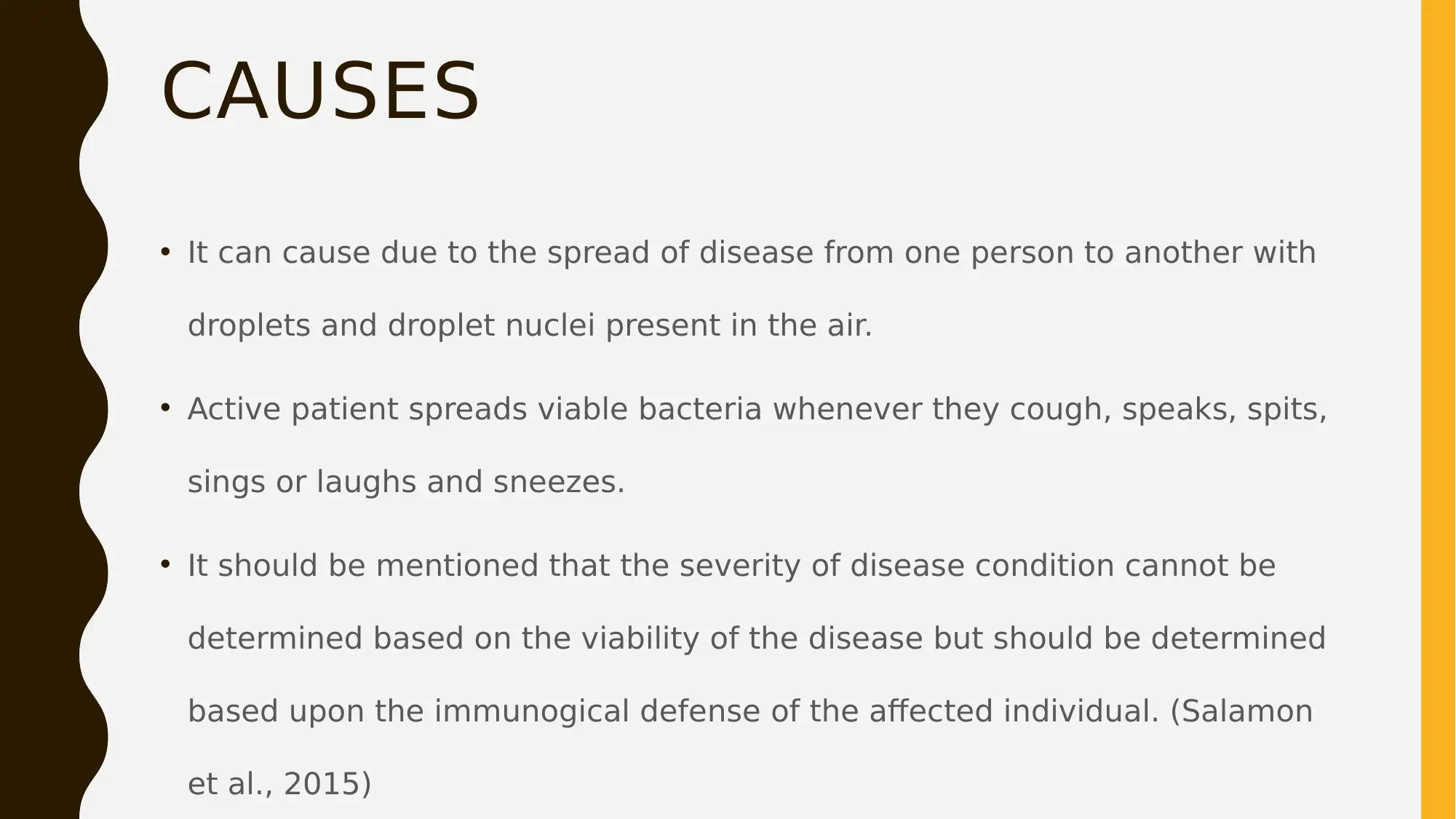
CAUSES
• It can cause due to the spread of disease from one person to another with
droplets and droplet nuclei present in the air.
• Active patient spreads viable bacteria whenever they cough, speaks, spits,
sings or laughs and sneezes.
• It should be mentioned that the severity of disease condition cannot be
determined based on the viability of the disease but should be determined
based upon the immunogical defense of the affected individual. (Salamon
et al., 2015)
• It can cause due to the spread of disease from one person to another with
droplets and droplet nuclei present in the air.
• Active patient spreads viable bacteria whenever they cough, speaks, spits,
sings or laughs and sneezes.
• It should be mentioned that the severity of disease condition cannot be
determined based on the viability of the disease but should be determined
based upon the immunogical defense of the affected individual. (Salamon
et al., 2015)
⊘ This is a preview!⊘
Do you want full access?
Subscribe today to unlock all pages.

Trusted by 1+ million students worldwide
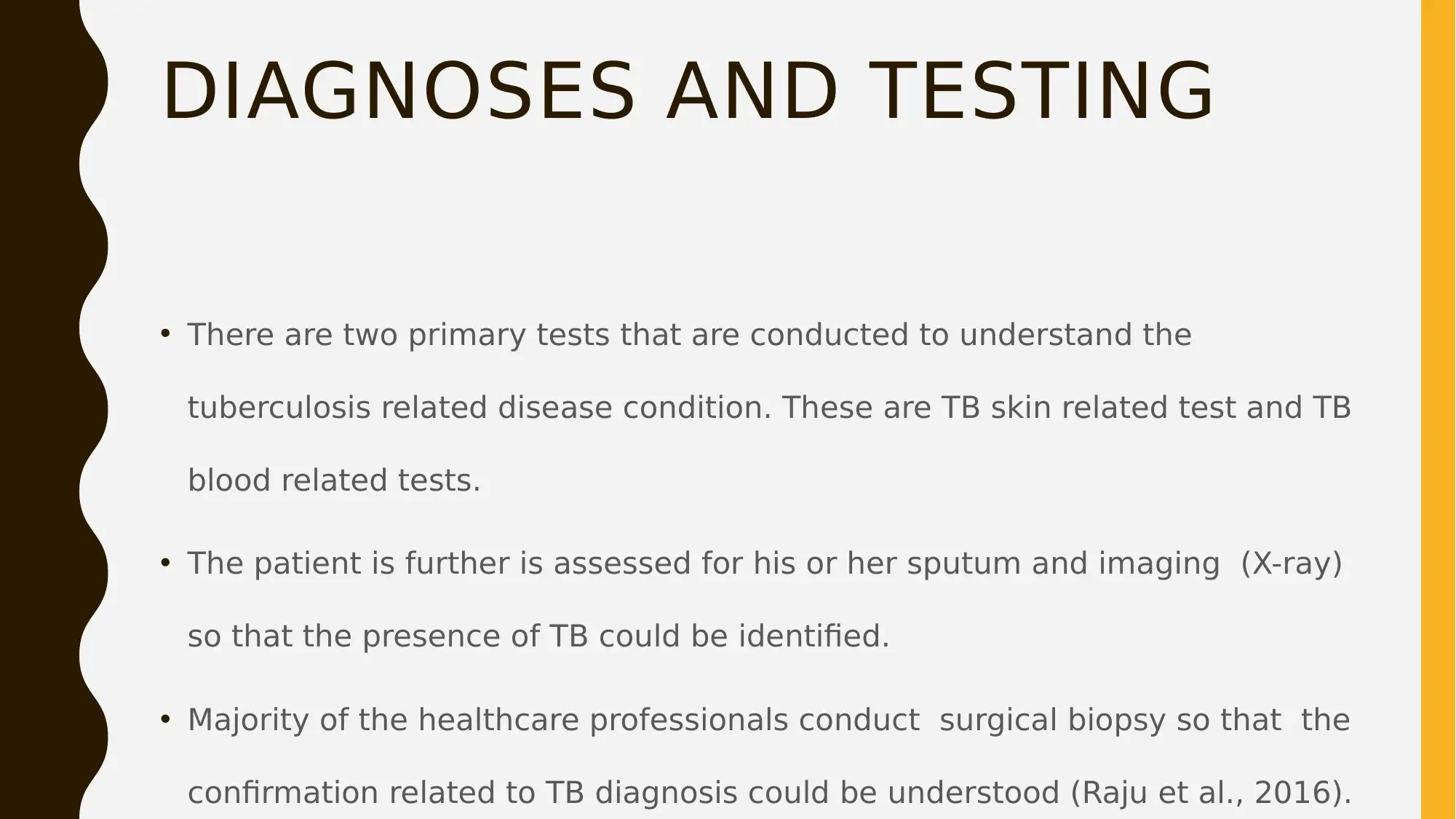
DIAGNOSES AND TESTING
• There are two primary tests that are conducted to understand the
tuberculosis related disease condition. These are TB skin related test and TB
blood related tests.
• The patient is further is assessed for his or her sputum and imaging (X-ray)
so that the presence of TB could be identified.
• Majority of the healthcare professionals conduct surgical biopsy so that the
confirmation related to TB diagnosis could be understood (Raju et al., 2016).
• There are two primary tests that are conducted to understand the
tuberculosis related disease condition. These are TB skin related test and TB
blood related tests.
• The patient is further is assessed for his or her sputum and imaging (X-ray)
so that the presence of TB could be identified.
• Majority of the healthcare professionals conduct surgical biopsy so that the
confirmation related to TB diagnosis could be understood (Raju et al., 2016).
Paraphrase This Document
Need a fresh take? Get an instant paraphrase of this document with our AI Paraphraser
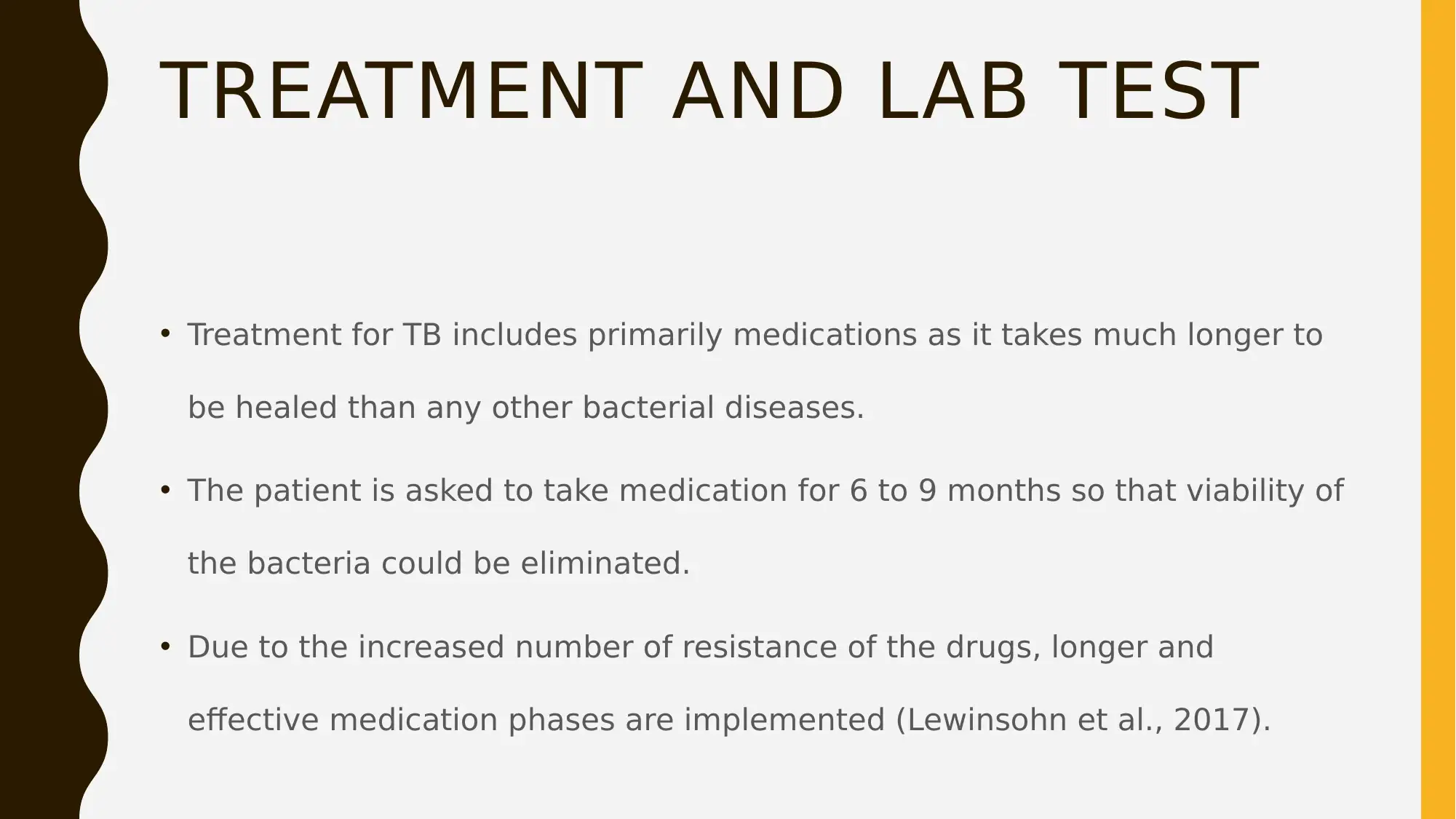
TREATMENT AND LAB TEST
• Treatment for TB includes primarily medications as it takes much longer to
be healed than any other bacterial diseases.
• The patient is asked to take medication for 6 to 9 months so that viability of
the bacteria could be eliminated.
• Due to the increased number of resistance of the drugs, longer and
effective medication phases are implemented (Lewinsohn et al., 2017).
• Treatment for TB includes primarily medications as it takes much longer to
be healed than any other bacterial diseases.
• The patient is asked to take medication for 6 to 9 months so that viability of
the bacteria could be eliminated.
• Due to the increased number of resistance of the drugs, longer and
effective medication phases are implemented (Lewinsohn et al., 2017).
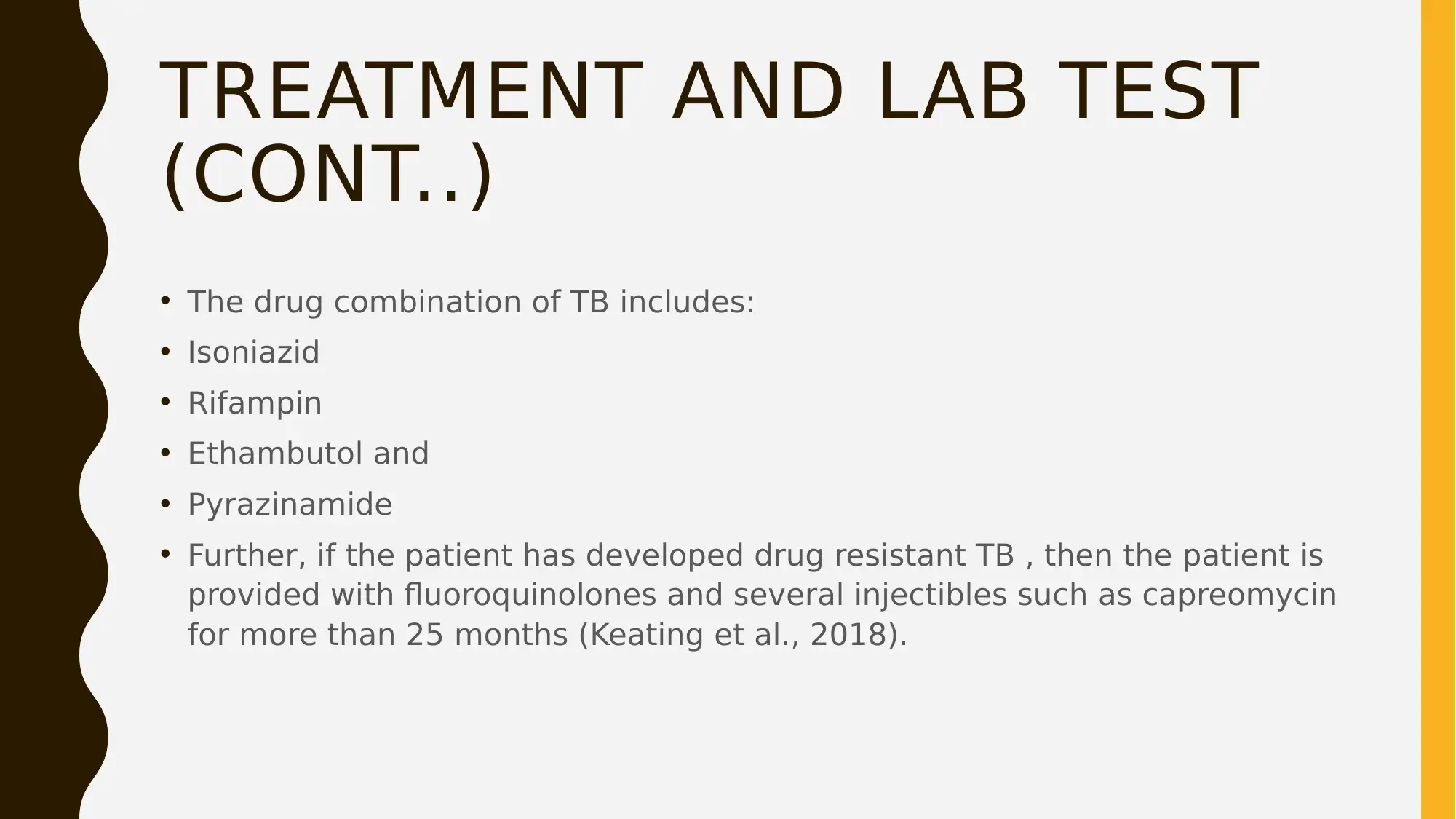
TREATMENT AND LAB TEST
(CONT..)
• The drug combination of TB includes:
• Isoniazid
• Rifampin
• Ethambutol and
• Pyrazinamide
• Further, if the patient has developed drug resistant TB , then the patient is
provided with fluoroquinolones and several injectibles such as capreomycin
for more than 25 months (Keating et al., 2018).
(CONT..)
• The drug combination of TB includes:
• Isoniazid
• Rifampin
• Ethambutol and
• Pyrazinamide
• Further, if the patient has developed drug resistant TB , then the patient is
provided with fluoroquinolones and several injectibles such as capreomycin
for more than 25 months (Keating et al., 2018).
⊘ This is a preview!⊘
Do you want full access?
Subscribe today to unlock all pages.

Trusted by 1+ million students worldwide
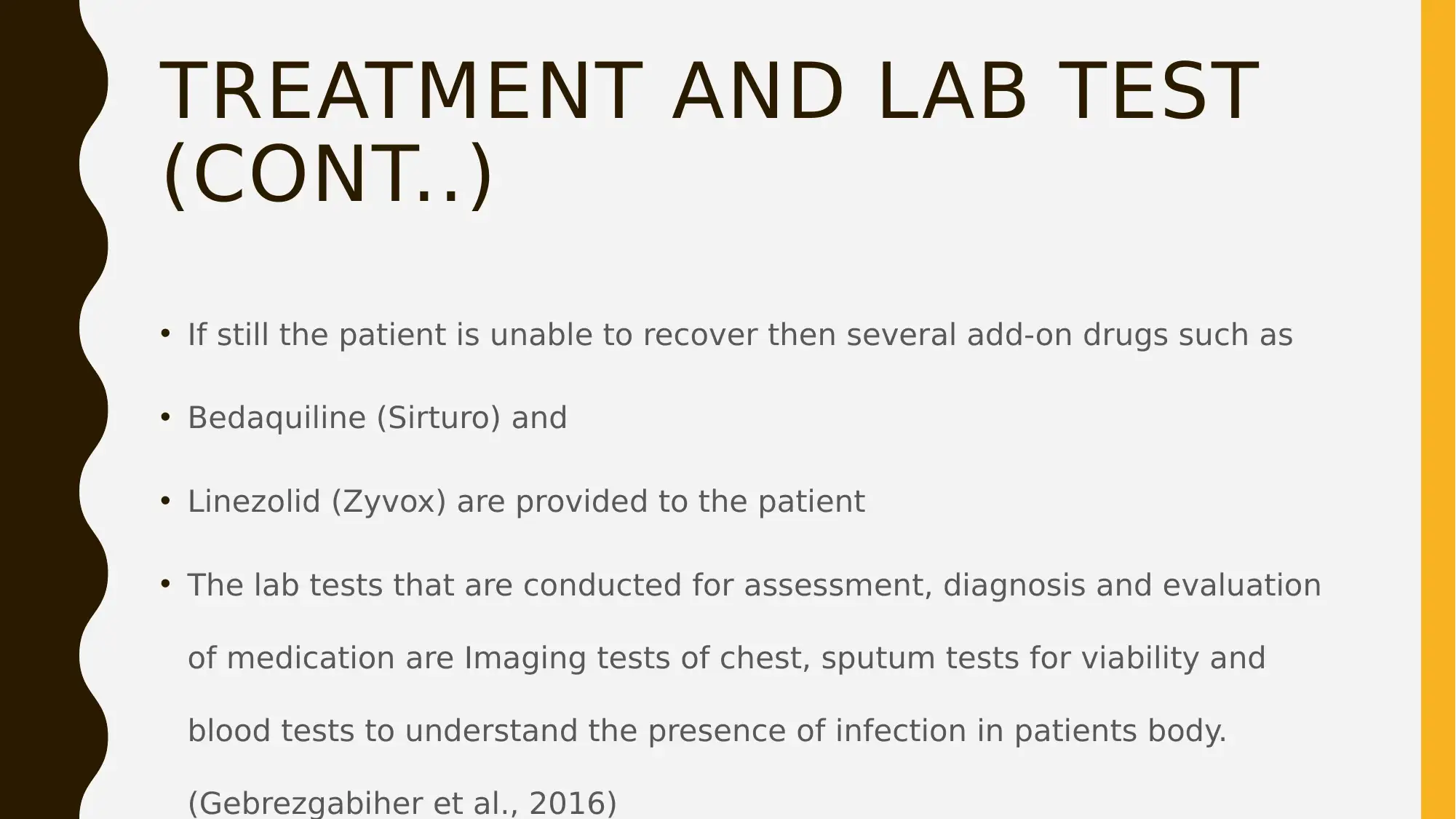
TREATMENT AND LAB TEST
(CONT..)
• If still the patient is unable to recover then several add-on drugs such as
• Bedaquiline (Sirturo) and
• Linezolid (Zyvox) are provided to the patient
• The lab tests that are conducted for assessment, diagnosis and evaluation
of medication are Imaging tests of chest, sputum tests for viability and
blood tests to understand the presence of infection in patients body.
(Gebrezgabiher et al., 2016)
(CONT..)
• If still the patient is unable to recover then several add-on drugs such as
• Bedaquiline (Sirturo) and
• Linezolid (Zyvox) are provided to the patient
• The lab tests that are conducted for assessment, diagnosis and evaluation
of medication are Imaging tests of chest, sputum tests for viability and
blood tests to understand the presence of infection in patients body.
(Gebrezgabiher et al., 2016)
Paraphrase This Document
Need a fresh take? Get an instant paraphrase of this document with our AI Paraphraser
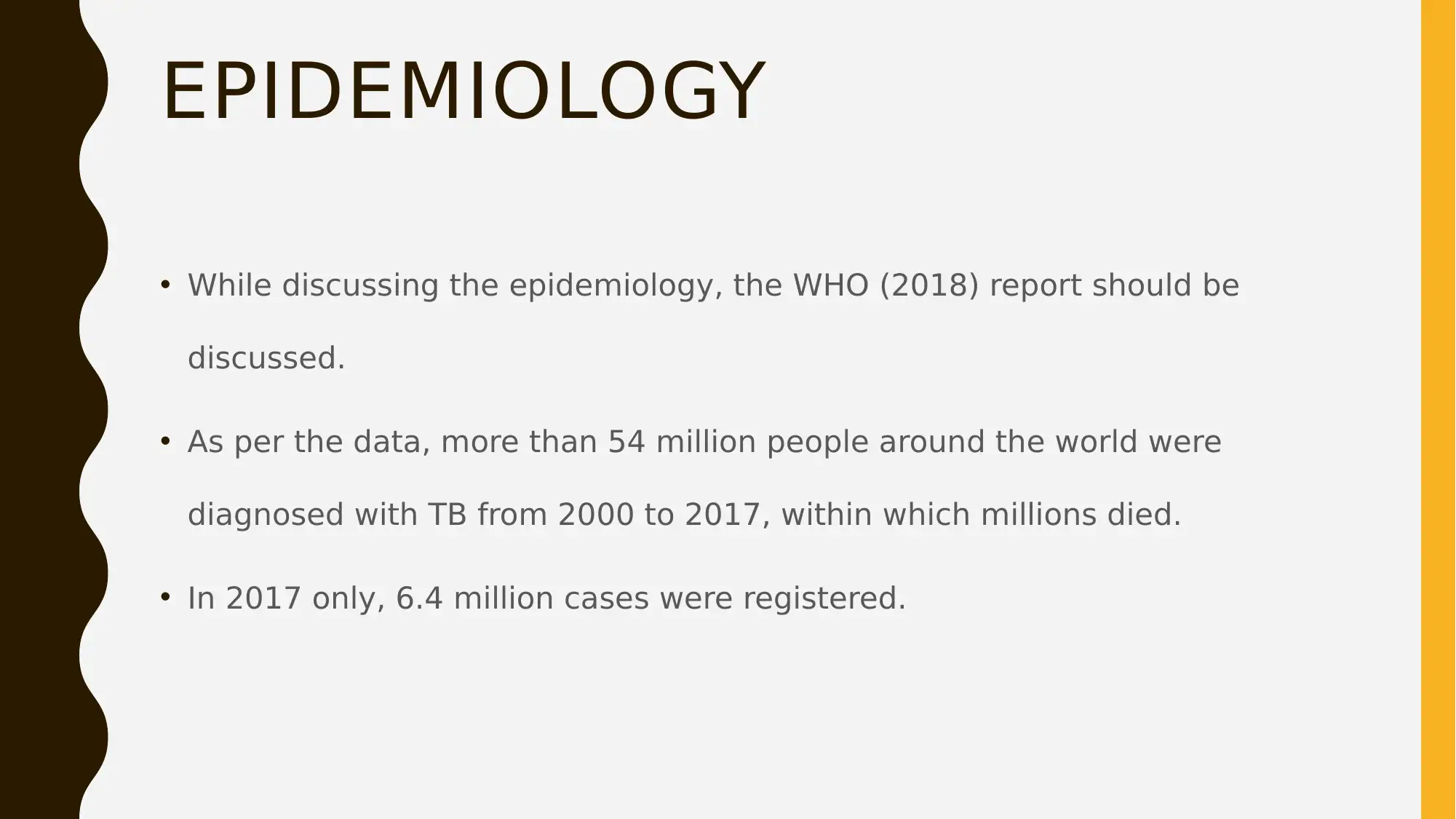
EPIDEMIOLOGY
• While discussing the epidemiology, the WHO (2018) report should be
discussed.
• As per the data, more than 54 million people around the world were
diagnosed with TB from 2000 to 2017, within which millions died.
• In 2017 only, 6.4 million cases were registered.
• While discussing the epidemiology, the WHO (2018) report should be
discussed.
• As per the data, more than 54 million people around the world were
diagnosed with TB from 2000 to 2017, within which millions died.
• In 2017 only, 6.4 million cases were registered.
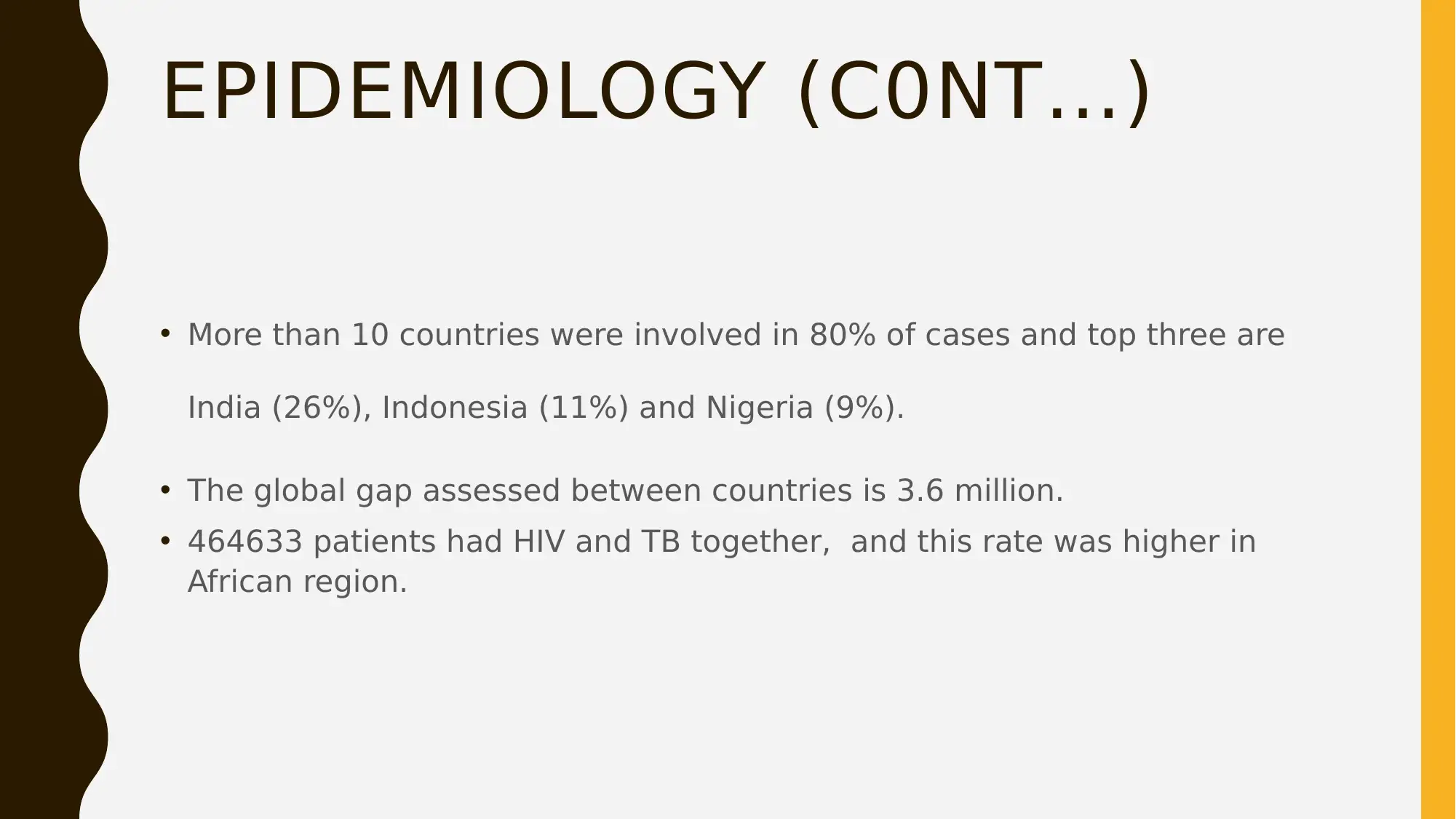
EPIDEMIOLOGY (C0NT…)
• More than 10 countries were involved in 80% of cases and top three are
India (26%), Indonesia (11%) and Nigeria (9%).
• The global gap assessed between countries is 3.6 million.
• 464633 patients had HIV and TB together, and this rate was higher in
African region.
• More than 10 countries were involved in 80% of cases and top three are
India (26%), Indonesia (11%) and Nigeria (9%).
• The global gap assessed between countries is 3.6 million.
• 464633 patients had HIV and TB together, and this rate was higher in
African region.
⊘ This is a preview!⊘
Do you want full access?
Subscribe today to unlock all pages.

Trusted by 1+ million students worldwide
1 out of 13
Related Documents
Your All-in-One AI-Powered Toolkit for Academic Success.
+13062052269
info@desklib.com
Available 24*7 on WhatsApp / Email
![[object Object]](/_next/static/media/star-bottom.7253800d.svg)
Unlock your academic potential
Copyright © 2020–2025 A2Z Services. All Rights Reserved. Developed and managed by ZUCOL.





